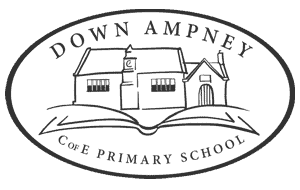
The new approach to teaching mathematics has transformed teaching in this subject.
Ofsted 2018
Art
At Down Ampney C of E primary School our Art and Design curriculum is designed to instil a deep appreciation for creativity and cultural expression. The school aims to develop pupils’ understanding and passion for the arts, nurturing their artistic skills and fostering an environment where imagination can flourish. Through our teaching, we promote inclusivity and diversity, celebrating different cultures and traditions.
Intent
We ensure that all Art and Design lessons inspire children to become artists rather than to simply ‘do art’. We aim to explicitly teach children techniques in using colours, pattern, texture, line, shape, form and space so they can experiment, invent and create their own works. We nurture a creative imagination where children are encouraged to reflect on their own progress and take pride in their journey through their sketch books. We teach children to evaluate and analyse creative works using the language of art, craft and design. We teach children about the great artists, craft makers and designers in History and ensure that these represent a diverse range of artists and styles.
Our Art and Design curriculum is based on the Access Art scheme and is linked to other curriculum areas or texts when it is meaningful to do so. Practical skills are explicitly taught each year, so children have the opportunity to develop and improve as artists. Children study a key artist in relation to the skill they are learning, ensuring they learn about artists from a wide range of backgrounds and styles over the year.
We enter the village art competitions and children have opportunities to display their artwork outside school. We set up internal art galleries to celebrate children’s work and invite local artists into school to work with the children and to discuss their careers.
Implementation
High-quality teaching inspires and challenges pupils to achieve their full potential. Teachers are knowledgeable, skilled, and enthusiastic about the arts, fostering a love for creativity in their pupils through engaging lessons and meaningful interactions. Medium Term Overviews are devised carefully to ensure there is a clear sequence of learning. These explicitly address the substantive knowledge as well as the practical, theoretical and disciplinary knowledge and skills for a unit.
Art lessons are well-planned, sequenced logically, and adapted to meet the needs of all learners. Pupils are provided with opportunities to experiment, reflect, and refine their artistic skills, with a focus on both technique and creativity. The school provides access to a wide range of art materials and resources, allowing pupils to explore different mediums and styles, and encourages the use of digital technologies for artistic expression.
Impact
Pupils develop confidence in their artistic abilities, express themselves with freedom and originality, and take pride in their creations. In a recent pupil voice, a child remarked, “Teachers show us how different people have used a technique to adapt their art but following the same ideas. I enjoy using the ideas of artists to base my art on and adapting their styles to mine.”
Assessment in art goes beyond mere outcomes and focuses on the process of artistic development, encouraging pupils to reflect on their progress, set goals for improvement, and celebrate their successes. Pupils’ work is valued and showcased both within the school and the wider community, promoting a culture of artistic appreciation and recognition.
The impact of the art curriculum extends beyond the classroom, fostering skills such as resilience, perseverance, critical thinking, and collaboration. Pupils learn to appreciate diverse perspectives, engage with different cultural traditions, and develop a lifelong love for the arts. Ultimately, the art curriculum in an outstanding primary school equips pupils with the tools and inspiration to become confident, creative, and culturally aware individuals.

